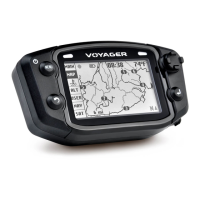17Trail Tech Voyager
While not required, using the wheel sensor is
recommended. It will collect more accurate speed and
distance data than GPS. Due to limitations in GPS
technology, physical sensors perform with more precision.
GPS sometimes loses track of your movements, while the
wheel sensor always knows when you are moving.
Two halves are required for the wheel sensor to function:
1. A magnet, on the spinning part of the wheel.
2. A speed sensor, on the non-spinning part of the wheel.
The magnet spins around tripping the sensor switch
each time--giving Voyager speed, distance and time
data to compare with the GPS data.
The magnet is installed on the brake rotor because
it spins with the wheel. The provided magnetic bolt
replaces a stock rotor bolt. If that will not work, glue
the spare magnet in a hole on the brake rotor. (JB
Weld or a similar slow-cure epoxy works well.)
After the magnet is in, the sensor is placed on a non-
spinning part the wheel, rotor shield, or bracket.
Physical Features » Precision Wheel Sensor
ATV Wheel Sensor Installation:
ATV Magnetic Bolt
ATV Speed
Sensor

